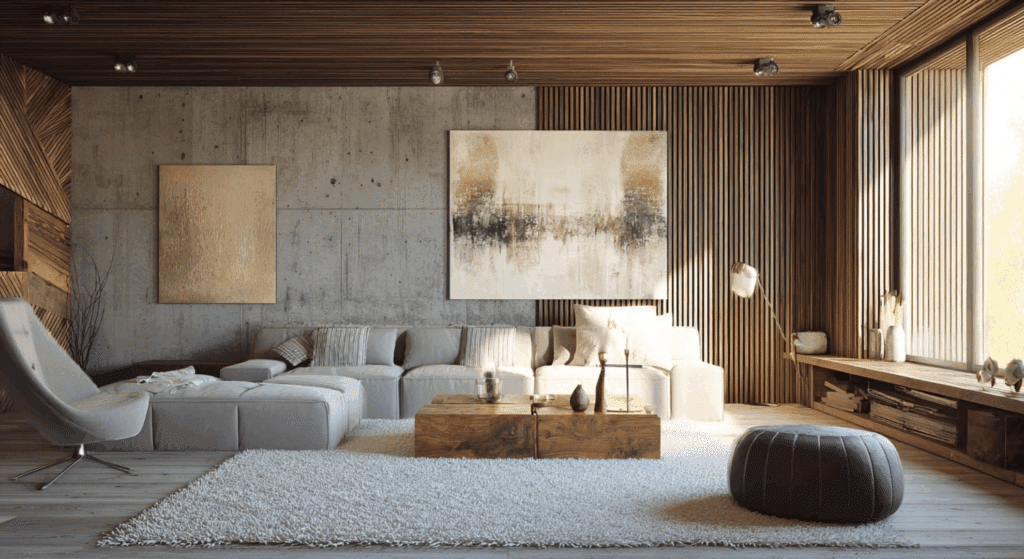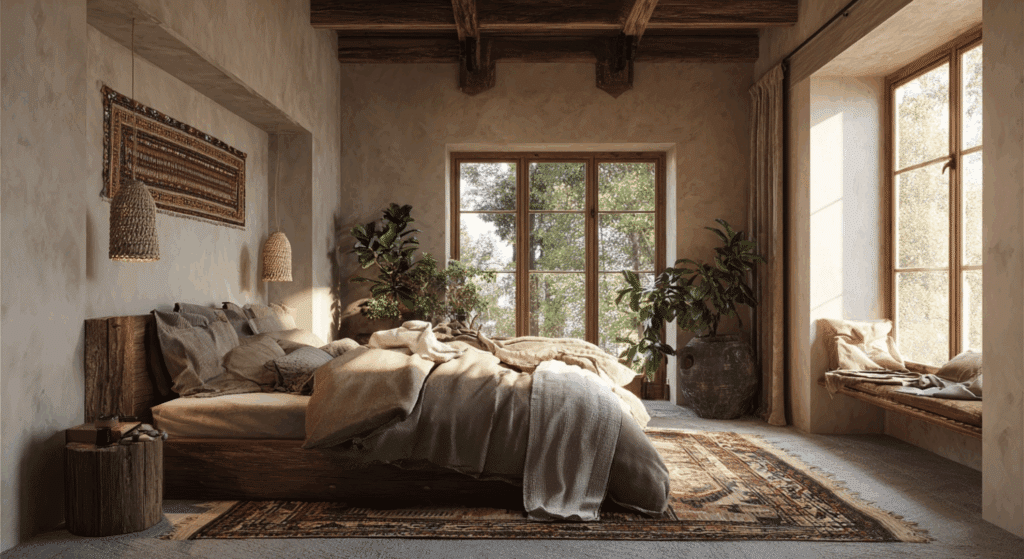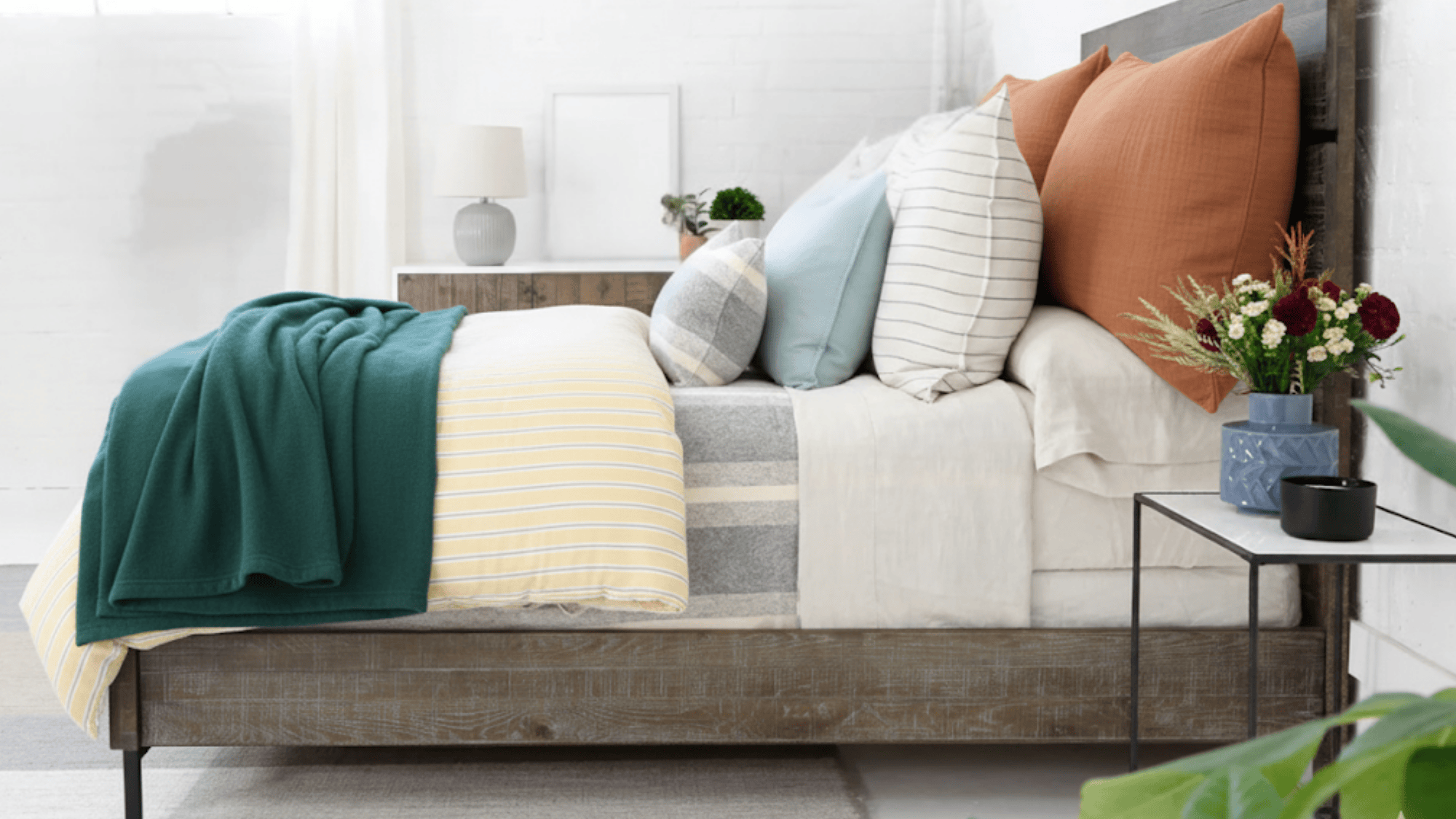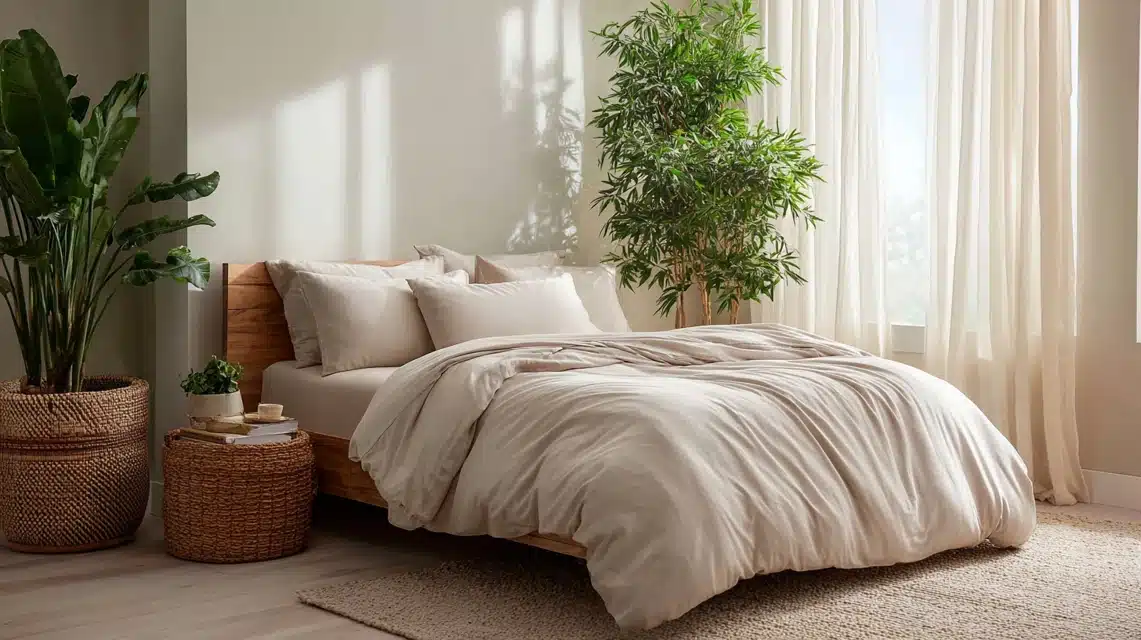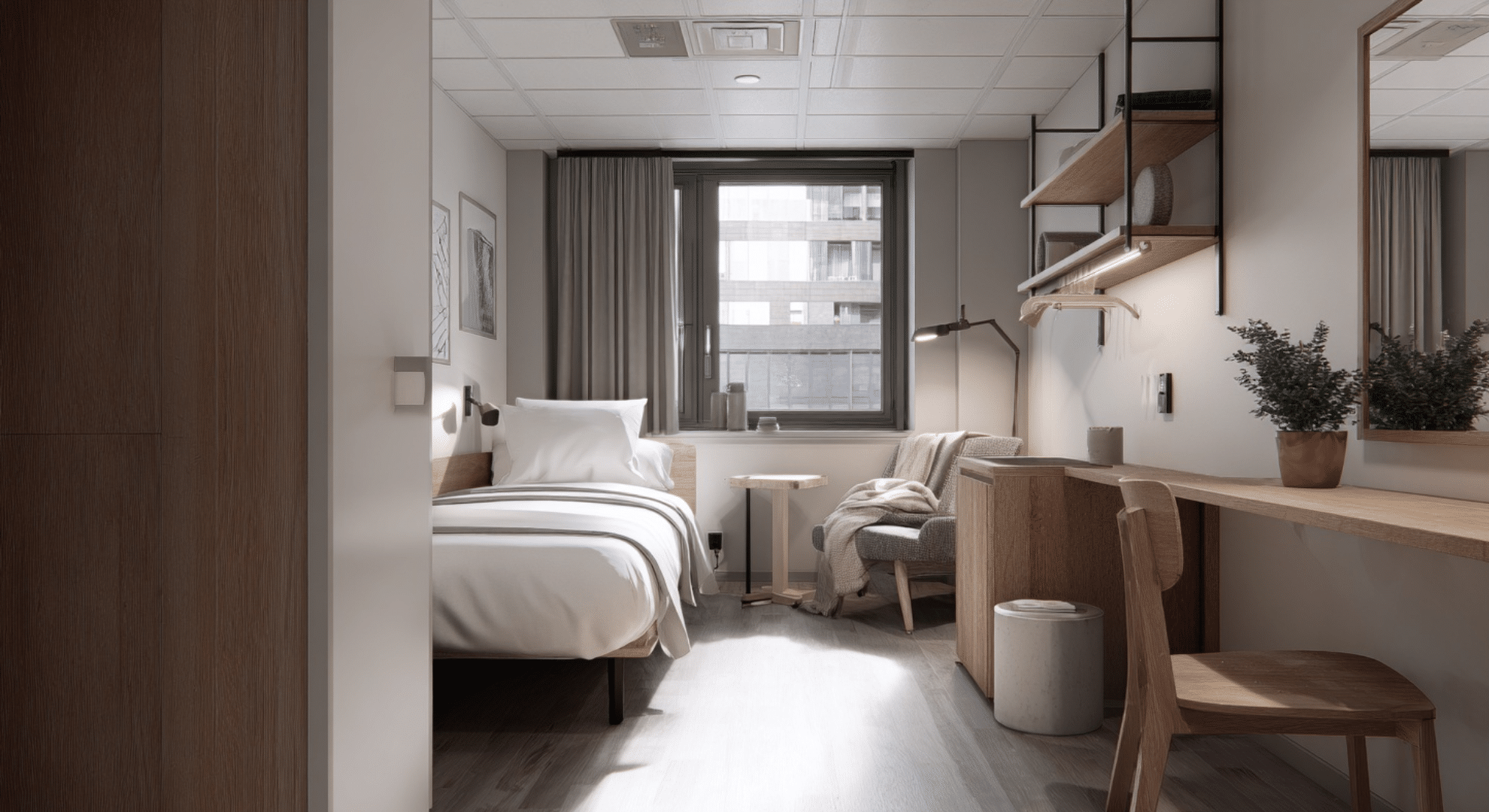I’ve always wanted my home to feel calm and lived-in: not too modern, not too old-fashioned. That’s why transitional interior design stood out to me.
It gave me a simple way to create balance, using soft colors, clean lines, and cozy textures without overdoing anything. It felt natural, easy, and comfortable.
If you’re drawn to that same kind of style, this guide is for you. You’ll learn what makes transitional design unique, how to use it in real rooms, and which details matter most.
From choosing the right furniture and color palette to avoiding common mistakes, you’ll get clear, simple steps to create a space that feels classic and personal without having to start over.
What is Transitional Interior Design?
Transitional interior design is a style that mixes the comfort of traditional design with the clean lines of modern style. It keeps the warm, homey feeling from older designs but adds the simple, less busy look of modern spaces.
This design doesn’t go all-in on just one side. It doesn’t feel too old-fashioned or too cold. Instead, it balances both. You’ll often see soft colors, simple furniture, and a mix of wood and metal. It feels calm and easy to live in.
People are loving this style more and more. Why? Because it feels fresh but still cozy. It works well in real homes, not just in magazines. You don’t need to throw everything out or buy all new stuff. Transitional design helps you update your space without losing the things you love.
That’s why so many folks are going for this look today: it’s easy, warm, and just feels right.
Core Characteristics of Transitional Interiors
Transition interior design keeps things easy and balanced. It takes what’s best from both traditional and modern styles and brings them together in a clean, cozy way. Here are the main parts that make this style stand out:
Neutral Color Base: Transitional spaces often use calm colors like soft white, beige, and gray. These shades keep the room feeling open and easy on the eyes. To avoid making it feel dull, you can add some color through pillows, art, or rugs. Think navy, olive green, or soft gold as accents; they bring life without making the space too loud.
Mix of Furniture Styles: One key part of transitional design is using both old and new furniture styles. You might see a classic sofa with rounded arms next to a simple, straight-lined coffee table. The idea is to keep things balanced. This mix brings allure and keeps the room from feeling stuck in one time period.
Textures and Materials: Texture adds life to a room. In transitional design, it’s common to use a mix like soft linen pillows, leather chairs, wood tables, and glass decor. Each texture gives a different feel, which makes the space more interesting. The goal is to add depth without making things feel too heavy or too light.
Balanced Layouts: Rooms in this style are calm and well-planned. You’ll often see things set up in a way that feels even, like matching chairs on both sides of a couch. There’s enough space to move around, and nothing feels squished or messy. It’s about peace, not clutter.
Lighting Choices: Lighting in transitional interiors is soft and simple. You’ll often find fixtures with clean shapes made from glass, bronze, or brushed nickel. Lamps and chandeliers help warm up the space without standing out too much. The light is usually soft and warm, not too bright or harsh.
Transitional Color Palettes and Materials
Transitional interior design is all about calm, comfort, and balance and that starts with the right colors and materials. Most spaces in this style use a soft, neutral base to create a relaxed mood. Common main colors include:
- White
- Cream
- Warm gray
- Taupe
- Light beige
These shades are often used on walls, large furniture, and rugs. They help the room feel open and clean. To keep things from looking flat or boring, small touches of deeper tones are added through accents like pillows, art, or decor.
Popular accent colors include:
- Navy
- Charcoal
- Olive green
- Soft gold
- Dusty blue
Using just a few colors per room keeps everything looking simple and pulled together without too much visual noise.
Materials in transitional spaces also follow the same idea—soft, natural, and not too flashy. Wood is often used, usually with a matte finish and in lighter to medium tones.
You’ll also find metals that are clean and understated. Typical material choices include:
- Wood: Light to medium tones, matte finish
- Metal: Brushed nickel, bronze, or matte black
- Fabric: Linen, cotton, leather (in neutral tones with light texture)
- Other textures: Glass (clear or smoked), stone (like marble or quartz), and low-pattern or solid rugs
All of these materials work together to keep the space looking timeless, clean, and welcoming. They don’t try too hard or stand out too much; they just feel right.
That’s the heart of transitional design: simple choices that create easy comfort.
Rules of Transitional Design You Should Know
Transitional design may look simple, but there’s smart thinking behind it. A few easy-to-remember rules can help you style your space the right way—where nothing feels out of place, and everything works together. These three are great starting points:
The 70/30 Rule
In transitional design, the 70/30 rule helps keep the style balanced. Choose one side; either traditional or modern to take up 70% of the space. The other style should fill the remaining 30%.
This mix keeps the room from leaning too far in one direction. It helps everything feel blended, comfortable, and not too stuck in one style.
The 3-5-7 Rule
This rule is great for styling shelves, tables, or walls. Group accessories in odd numbers: 3, 5, or 7 items. Odd groupings feel more natural to the eye. Use different sizes or heights to add interest.
It works with books, candles, vases, or framed art. Just keep the grouping simple, balanced, and in line with the room’s calm look.
Proportion and Scale
In transitional design, size matters. Use furniture that fits the room—not too big or too small. A giant couch in a small room will feel off. A tiny table in a large space will get lost. Match the height, width, and depth of each piece so the room feels balanced.
A good proportion helps everything work together smoothly.
Transitional Interior Design Ideas
Want to bring a calm, balanced look to your home? Here are simple ideas to mix modern and classic styles with ease:
1. Neutral Foundation with Layered Textures
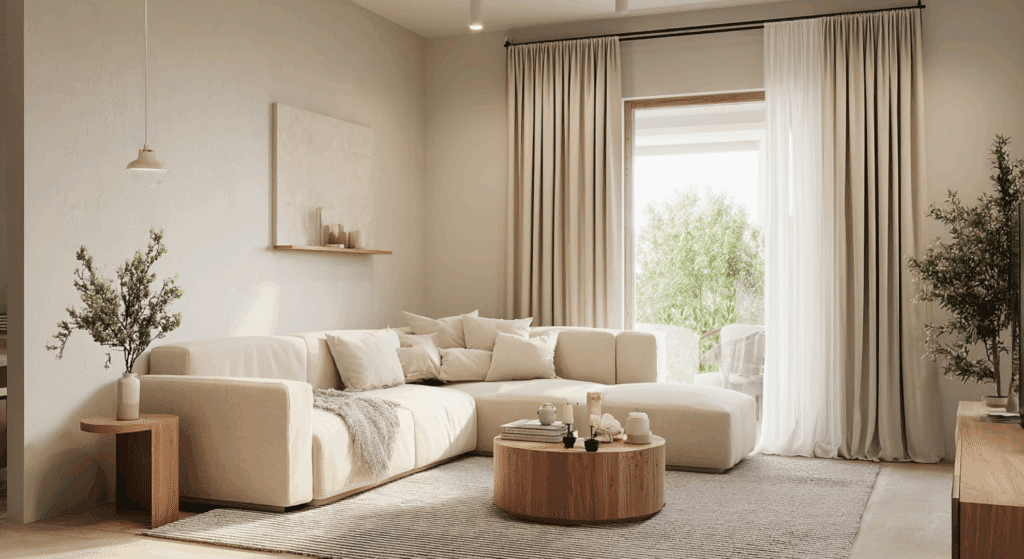
Start with soft shades like ivory, taupe, or warm gray. Then add texture using soft drapes, nubby rugs, or smooth leather seating.
This gentle layering gives depth without loud colors and makes the space feel calm, comfortable, and easy to enjoy without being boring or flat.
2. Mixed Metal Accents

Use a thoughtful mix of metals like brushed brass, matte black, or antique nickel. Spread them across light fixtures, knobs, and decor.
Mixing finishes adds a touch of interest and richness without overwhelming the design. Just keep it balanced, two to three metals in one space works well.
3. Curved Meets Clean Lines
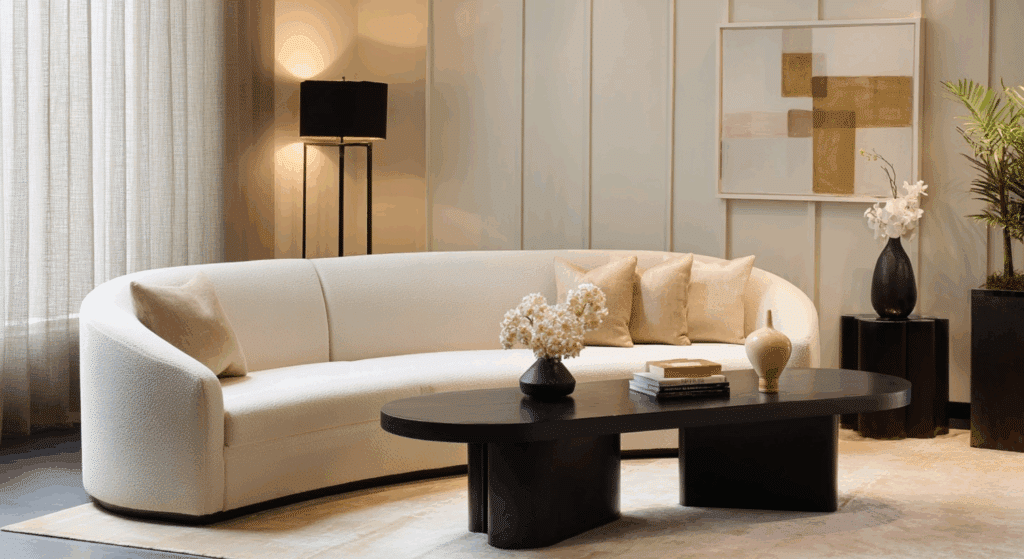
Put a curved bench near a sharp-lined desk or match a soft-edge armchair with a straight-leg side table. This pairing of gentle and strong shapes brings quiet energy to a room.
It keeps the look soft yet structured, which is key in transitional design.
4. Classic Molding with Modern Art

Keep traditional details like baseboards or chair rails, but pair them with bold, modern artwork. A simple black frame around abstract prints or large photographs adds contrast.
The mix helps old and new elements work side by side without clashing or feeling forced.
5. Warm Wood with Soft Fabrics
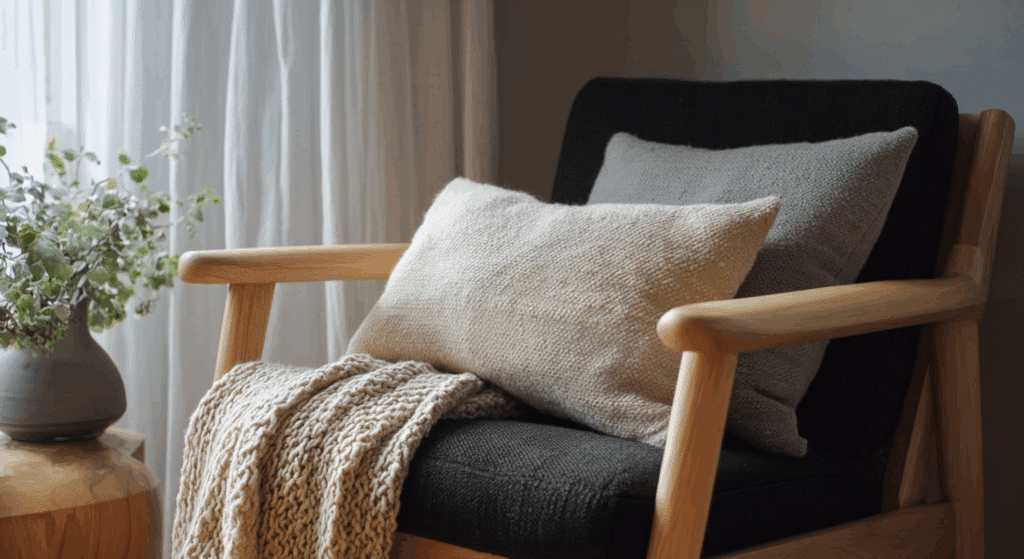
Instead of cool stone, bring warmth through wood and pair it with soft, cozy materials. Try oak furniture with cotton slipcovers or walnut shelving with a wool throw.
This mix brings in natural beauty and texture, keeping the space feeling grounded and peaceful.
6. Layered Lighting with Mixed Fixtures

Use several types of lighting: ceiling, floor, and table so the room has depth and flexibility. Choose clean designs in different materials, but keep a neutral tone.
Layering light sources helps shape the mood without relying on one big fixture to carry the whole space.
7. Simple Styling with Purpose

Choose decor that has meaning or usefulness. A few well-chosen books, handmade pottery, or an heirloom bowl can stand on their own.
Transitional rooms don’t need clutter; they just need a few pieces that feel real and personal, not like they came from a showroom.
8. Tone-on-Tone Layering
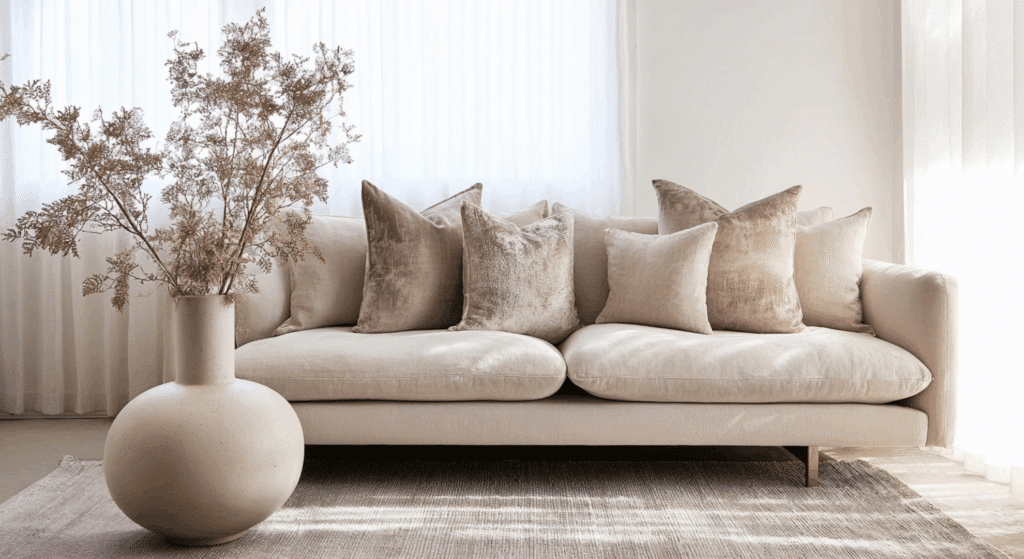
Stick to one main color, like beige or gray, and add depth using textures in the same shade. Think a velvet chair next to a linen curtain or a matte vase on a stone table.
It adds quiet richness without pulling attention away from the whole room.
9. Balanced Fabric Use

Instead of using many fabrics in one place, use each one with purpose. A velvet headboard, a cotton blanket, and a leather ottoman each serve a role.
Let them work together by keeping the colors soft and the shapes simple, so the room feels smooth and not overdone.
10. Symmetrical Layouts with Flexibility

Symmetry creates order, but add a small twist. Use matching lamps on either side of a bed but try different shades or bases. Or balance two chairs with a unique table between.
This keeps the design neat but still relaxed and not too predictable.
11. Subtle Color Pops in Neutral Rooms
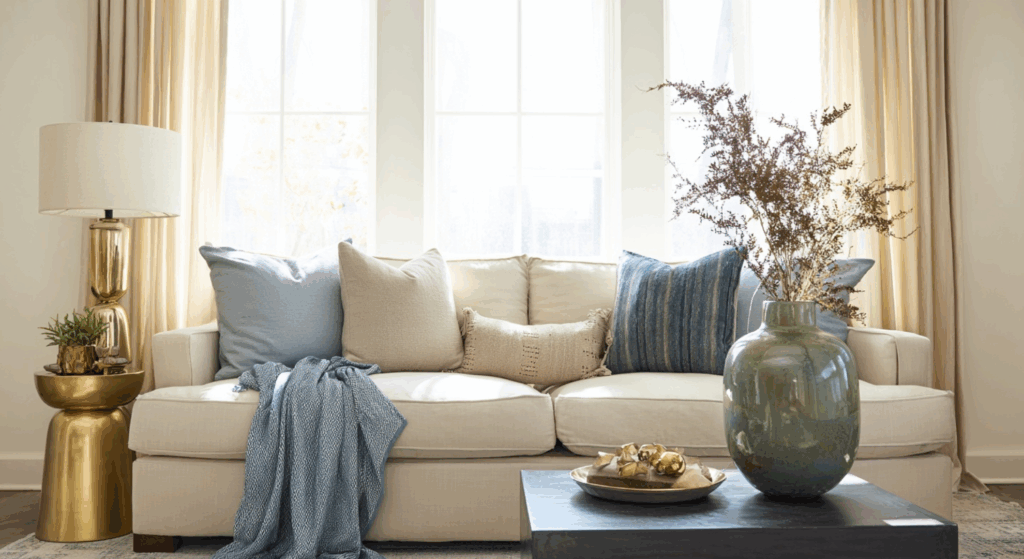
Bring color in softly; try muted rust, soft olive, or dusty blue in artwork, pottery, or a throw pillow. These tones add life without disturbing the calm feel.
Stick to one or two accent colors across the room to keep it feeling natural and connected.
12. Comfort-First Bedroom Design

Focus on soft, layered elements that feel good to use. Think plush rugs, cozy duvets, and smooth wood or padded headboards.
Use soft lighting with dimmers and avoid anything too sharp or cold. This approach makes the bedroom feel like a gentle escape from the day.
13. Mirror Placement That Expands Space
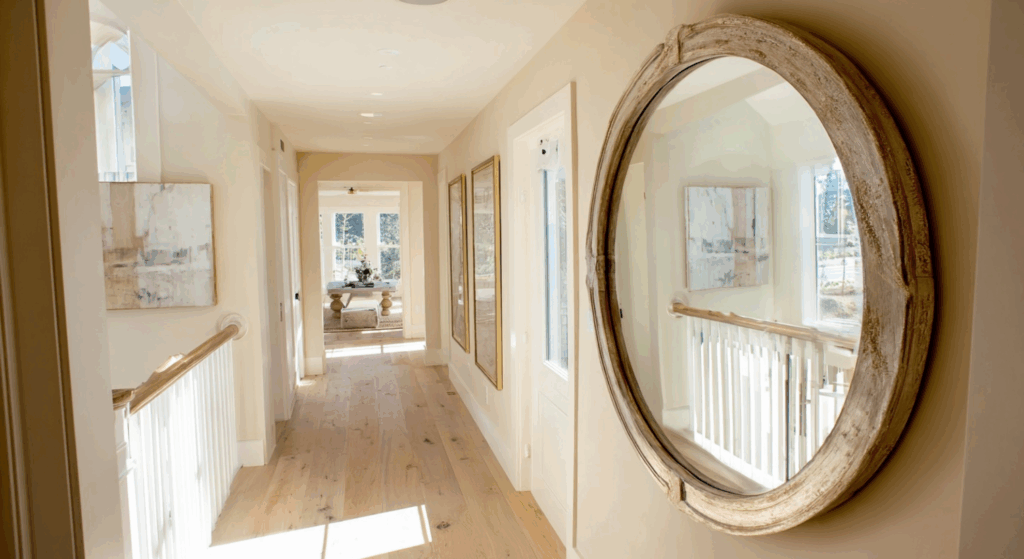
Use large mirrors across from windows to reflect light and make rooms feel bigger. Choose frames that combine both modern and traditional styles, maybe sleek shapes with antique finishes.
These mirrors don’t just decorate, they help the space breathe and feel more open without adding clutter.
14. Quiet Pattern Choices

Use low-key patterns that don’t take over. Stripes, small checks, or tone-on-tone prints on rugs, bedding, or drapes work best.
Keep the pattern colors close to your base palette so they blend in gently. The goal is movement in the space, not noise.
15. Transitional Entry That Feels Welcoming
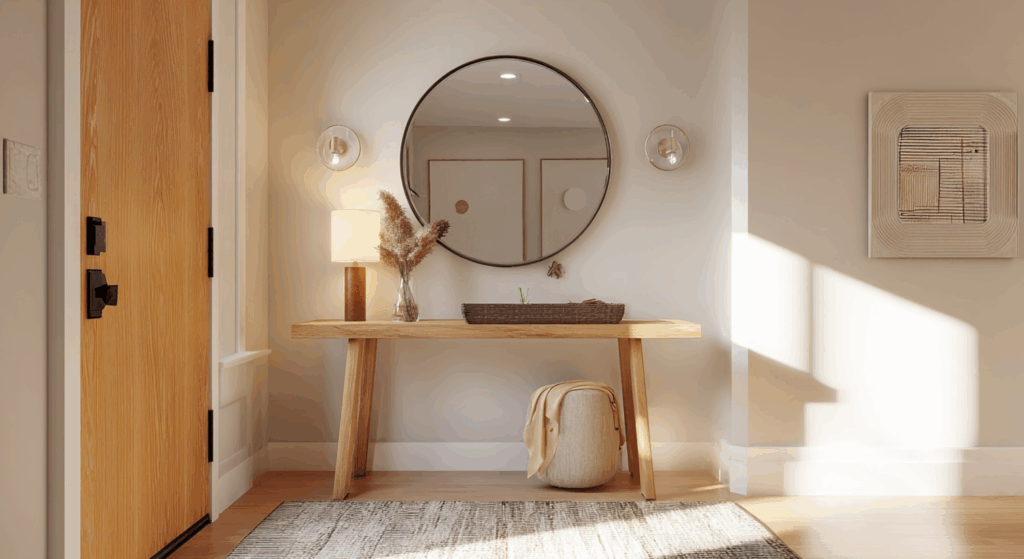
Set up a small entry with function and style. Try a wood bench, a soft rug, and a mirror with rounded edges. Add a tray for keys and a small lamp.
This simple setup shows the home’s style right away and keeps the space useful and tidy.
Is Transitional Style Right for You?
Transitional style might be a great fit if you like a home that feels calm, simple, and cozy—but still has a bit of character. You don’t want things too modern or too old-fashioned.
You like soft colors, clean shapes, and furniture that feels good to use, not just nice to look at.
This style works well if you want a space that looks pulled together but not overdone. You enjoy a mix of smooth lines and soft fabrics. You like a home that’s easy to keep tidy and doesn’t feel crowded with stuff.
If you’re someone who wants timeless style without following every trend, transitional could be perfect. It’s flexible, practical, and works in just about any type of home: from apartments to family houses.
You get comfort, style, and balance all in one. So if you want a space that feels peaceful and welcoming, this style is worth considering.
What Sets Transitional Interior Design Apart
What truly sets transitional interior design apart is how effortlessly it fits into everyday life. It’s not about following strict rules or chasing trends.
Instead, it gives you freedom. You can keep the pieces you already love and slowly mix in newer ones without it feeling mismatched or forced.
This style is also easy to adjust as life changes. If you’re updating a space after years or just refreshing a corner, it lets you make small changes that still feel meaningful. It’s simple without being plain and polished without being cold.
More than just a look, transitional design is about how a room feels, calm, steady, and lived-in. That sense of quiet balance is what makes it different. It’s not trying to impress; it’s made for real life. And that’s why so many people choose it; it just works without trying too hard.
Transitional Interior Design vs. Other Styles
Not sure how transitional design compares to other popular styles? Here’s a quick breakdown. While some styles go all-in on bold or rustic looks, transitional design stays balanced, soft, and easy to live with.
It pulls the best parts from old and new without leaning too far either way.
| Style | Overall Look | Key Difference from Transitional |
|---|---|---|
| Contemporary | Sleek, minimal, often cool-toned | Transitional adds warmth, texture, and softer lines. |
| Traditional | Rich, detailed, formal | Transitional uses fewer details and brighter colors. |
| Modern Farmhouse | Rustic, cozy, casual | Transitional feels more polished, neutral, and less rustic. |
| Mid-Century Modern | Clean lines, retro tones | Transitional tones down color and focuses on softer finishes. |
| Scandinavian | Bright, airy, minimal | Transitional is warmer and uses more layered materials. |
| Industrial | Raw, edgy, exposed materials | Transitional skips the roughness for a smoother, softer feel. |
| Boho | Colorful, eclectic | Transitional avoids clutter and sticks to a calmer palette. |
Each style has its magnetism, but the transitional design stands out for its balance. It’s calm, classic, and fits just about anywhere without feeling too plain or too bold.
Common Mistakes to Avoid in Transitional Design
Transitional design is all about balance, but even small missteps can throw off the look. If you’re aiming for a space that feels calm and put-together, watch out for these common mistakes:
- Too many mixed styles: Stick to blending traditional and modern—don’t bring in farmhouse, industrial, or boho all at once.
- Overdoing neutrals: Neutrals are key, but without texture or contrast, the room can feel dull.
- Unbalanced furniture shapes: Use both curved and clean lines, but avoid leaning too hard in one direction.
- Bad lighting choices: Lighting that’s too harsh or outdated can take away from the relaxed feel.
- Too much decor: Transitional style needs open space. Avoid over-decorating with too many objects or wall art.
- Wrong scale and size: Furniture that’s too big or too small for the room throws off the balance.
- Clashing finishes: Mixing too many metal or wood tones can make things look messy—stick to two or three.
Keep these in mind as you design. A little attention to detail helps keep your space feeling easy, clean, and truly transitional.
Conclusion
Transitional interior design helped me create a space that feels calm, simple, and welcoming. I didn’t have to change everything; just a few thoughtful updates made a big difference.
Mixing soft colors, clean lines, and warm textures gave my home the balance I was looking for.
Now it’s your turn. Look around your space and think about what small changes could bring that same feeling. Maybe it’s swapping out bold colors for neutrals or pairing old furniture with modern touches.
You’ve got the tools to get started; this guide gave you the basics. Just keep it balanced and make it your own.
Want more ideas and tips? Check out other blogs for helpful ways to shape your home into something that feels just right!



